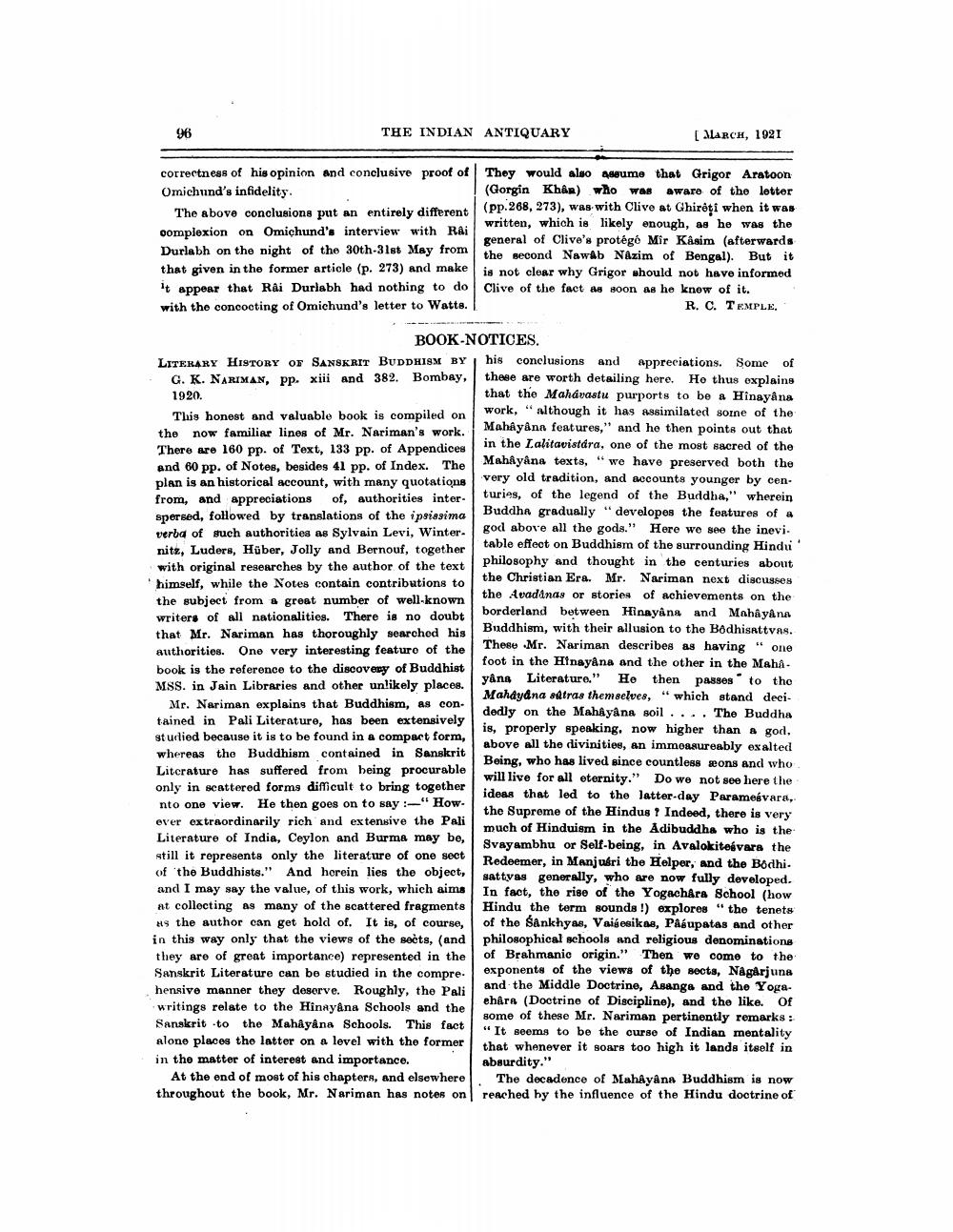________________
THE INDIAN ANTIQUARY
[MARCH, 1921
correctness of his opinion and conclusive proof of Omichund's infidelity.
The above conclusions put an entirely different oomplexion on Omichund's interview with RA Durlabh on the night of the 30th-31st May from that given in the former article (p. 273) and make It appear that Rai Durlabh had nothing to do with the concocting of Omichund's letter to Watte.
They would also Adeume that Grigor Aratoon (Gorgin Khan) who was aware of the letter (pp. 268, 273), was with Clive at Ghiroi when it was written, which is likely enough, as he was the general of Clive's protégé Mir Kasim (afterwards the second Nawab Nazim of Bengal). But it is not clear why Grigor should not have informed Clive of the fact as soon as he knew of it.
R. C. TEMPLE
BOOK-NOTICES. LITERARY HISTORY OF SANSKRIT BUDDHISM BY his conclusions and appreciations. Some of
C. K. NARIMAN, pp. xiii and 382. Bombay, these are worth detailing here. Ho thus oxplains 1920.
that the Mahavastu purporty to be a Hinaya na This honest and valuable book is compiled on
work," although it has assimilated some of the the now familiar lines of Mr. Nariman's work.
Mahayana features, and he then points out that There are 160 pp. of Text, 133 pp. of Appendices
in the Lalitavistdra, one of the most sacred of the and 60 pp. of Notes, besides 41 pp. of Index. The
Mahîyana texts, "we have preserved both the plan is an historical account, with many quotations
very old tradition, and accounts younger by cen. from, and appreciations of, authorities inter
turies, of the legend of the Buddha," wherein spersed, followed by translations of the ipsissima
Buddha gradually "developes the features of a verba of such authorities as Sylvain Levi, Winter.
god above all the gods." Here we see the inevi.
table effect on Buddhism of the surrounding Hindui nita, Luders, Hüber, Jolly and Bernouf, together with original researches by the author of the text
philosophy and thought in the centuries about
the Christian Era. Mr. Nariman next discusses himself, while the Notes contain contributions to the subject from a great number of well-known
the Avadanas or stories of achievements on the writers of all nationalities. There is no doubt
borderland between Hinayang and Mahayana that Mr. Nariman has thoroughly searched his
Buddhism, with their allusion to the Bodhisattvas.
These Mr. Nariman describes as having" one authorities. One very interesting featuro of the
foot in the Hinayana and the other in the Mahabook is the reference to the discovery of Buddhist
yâng Literature." Ho then passes to the MSS. in Jain Libraries and other unlikely places.
Mahdydna stras themselves," which stand deciMr. Nariman explains that Buddhism, as con.
dedly on the Mahậyana soil .... The Buddha tained in Pali Literature, has been extensively
is, properly speaking, now higher than a god, studied because it is to be found in a compact form,
above all the divinities, an immeasureably exalted whereas the Buddhism contained in Sanskrit
Being, who has lived since countless xeons and who Literature has suffered from being procurable
will live for all eternity." Do we not see here the only in scattered forms difficult to bring together
ideas that led to the latter-day Paramesvara, nto one view. He then goes on to say :-" How
the Supreme of the Hindus 1 Indeed, there is very ever extraordinarily rich and extensive the Pali
much of Hinduism in the Adibuddha who is the Literature of India, Ceylon and Burma may be,
Svayambhu or Self-being, in Avalokitesvars the still it represents only the literature of one sect
Redeemer, in Manjusri the Helper, and the Bodhi. of the Buddhists." And herein lies the object,
sattyas generally, who are now fully developed. and I may say the value, of this work, which aims In fact, the rise of the Yogachåra School (how at collocting as many of the scattered fragments Hindu the term sounds!) explores" the tenets as the author can get hold of. It is, of course, of the Sankhyas, Vaigesikas, Pasupatas and other in this way only that the views of the sečts, (and philosophical schools and religious denominations they are of great importance) represented in the of Brahmanio origin." Then we come to the Sanskrit Literature can be studied in the compre.
exponents of the views of the sects, Nagarjuna hensive manner they deserve. Roughly, the Pali
and the Middle Doctrine, Asanga and the Yoga
ehera (Doctrine of Discipline), and the like. Of writings relate to the Hinayana Schools and the
some of these Mr. Nariman pertinently remarks: Sanskrit to the Mahảyana Schools. This fact " It seems to be the ourse of Indian mentality Alone places the latter on a level with the former
that whenever it soars too high it lands itself in in the matter of interest and importance.
absurdity." At the end of most of his chapters, and elsewhere. The decadence of Mahâyâna Buddhism is now throughout the book, Mr. Nariman has notes on reached hy the influence of the Hindu doctrine of




